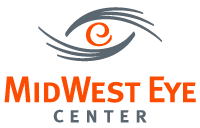Home » Blog » What Is the Silent Thief of Sight? Let’s Discuss Glaucoma.
What Is the Silent Thief of Sight? Let’s Discuss Glaucoma.
Posted by: Midwest Eye Center in Eye Health

Glaucoma comprises various eye issues that harm the optic nerve and can affect individuals over 60. However, early treatment often prevents blindness caused by glaucoma. Being aware of this enables you to take proactive measures to safeguard your vision and maintain control over your health.
Who Is at Risk for Glaucoma?
According to the American Academy of Ophthalmology, certain individuals face a higher risk of developing glaucoma, including:
- are over age 40
- have family members with glaucoma
- are of African, Hispanic, or Asian heritage
- have high eye pressure
- are farsighted or nearsighted
- have had an eye injury
- use long-term steroid medications
- have corneas that are thin in the center
- have thinning of the optic nerve
- have diabetes, migraines, high blood pressure, poor blood circulation, or other health problems affecting the whole body
Talk to your eye doctor about your risk for glaucoma. People with several risk factors from the list above have an even higher chance of being diagnosed with glaucoma.
Glaucoma Diagnosis
Understanding that only a full eye exam can definitively diagnose glaucoma is crucial. Regular eye checkups are essential, especially if you have risk factors, to catch the disease early and start treatment right away. A glaucoma screening that only checks eye pressure isn’t enough to detect glaucoma. Knowing this will help you prepare for your upcoming eye exam and ensure you get a complete eye health evaluation.
During a glaucoma exam, your eye doctor will:
- measure your eye pressure
- inspect your eye’s drainage angle
- examine your optic nerve for damage
- test your peripheral (side) vision
- take a picture or computer measurement of your optic nerve
- measure the thickness of your cornea
What Are the Symptoms of Glaucoma?
Some people may show no signs of damage but have higher-than-normal eye pressure, a condition called ocular hypertension. That’s why glaucoma is known as a silent thief of sight. In its early stages, glaucoma has no symptoms. However, patients considered “glaucoma suspects”-those with one or more risk factors—are at a higher risk of developing glaucoma even if their eye pressure is normal. This is why regular monitoring by your eye doctor is so important if you are a glaucoma suspect.
What Is the Best Glaucoma Treatment?
Successfully treating glaucoma requires teamwork between you and your eye doctor. Your active involvement in understanding your condition and following the treatment plan is crucial. Your eye doctor will suggest the best treatment options for your needs, which may include medication, laser treatment, or surgery. We are here to support you in managing and stopping the disease from progressing. To learn more about glaucoma treatment, call us TODAY to schedule your appointment.

The content is researched and vetted by the Glaucoma Research Foundation, the American Academy of Ophthalmology, and the American Optometric Association. This blog provides information and discussion about eye health and related subjects. The content provided in this blog and any linked materials are not intended and should not be considered medical advice. If the reader or any other person has a medical concern, they should consult with an appropriately licensed physician.
Recent Comments
Archives
- December 2025
- November 2025
- October 2025
- September 2025
- August 2025
- July 2025
- June 2025
- May 2025
- April 2025
- March 2025
- February 2025
- January 2025
- December 2024
- November 2024
- October 2024
- September 2024
- August 2024
- June 2024
- May 2024
- April 2024
- March 2024
- February 2024
- January 2024
- December 2023
- November 2023
- October 2023
- September 2023
- August 2023
- July 2023
- June 2023
- May 2023
- April 2023
- March 2023
- January 2023
- January 2018
